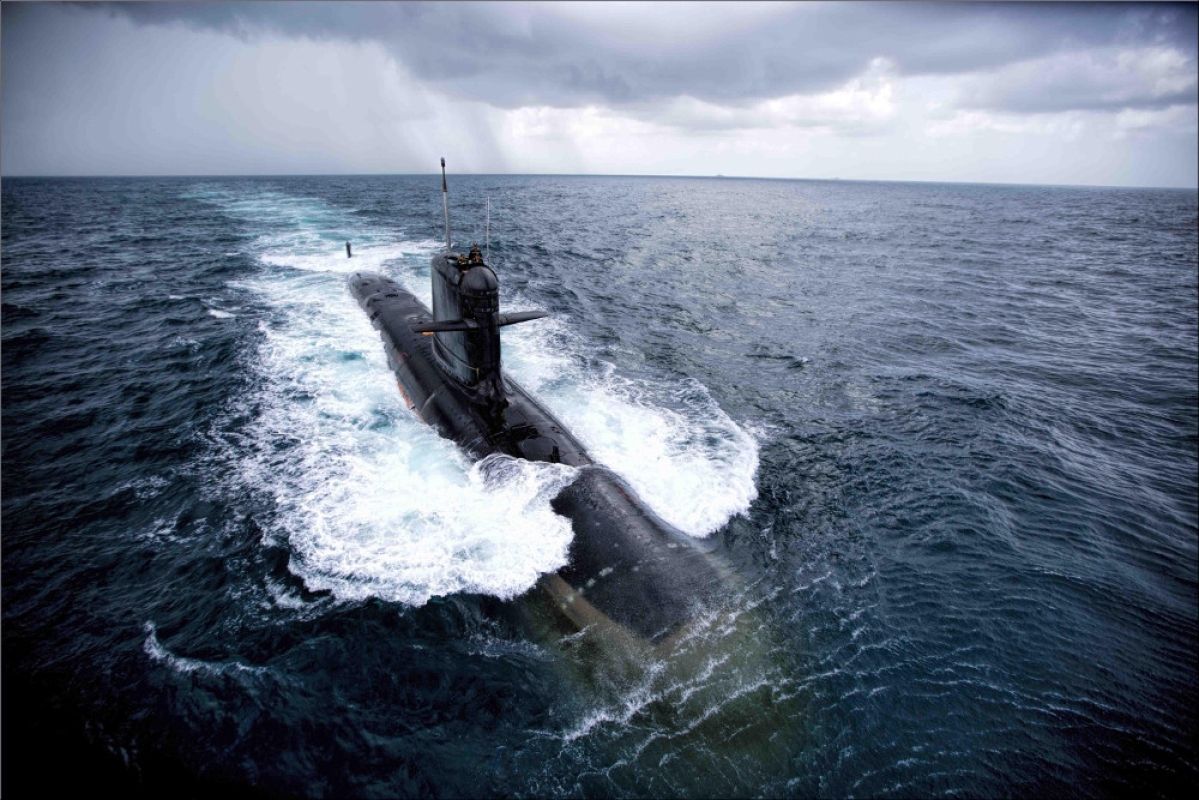
SOURCE: Swarajya
The Indian Navy, by far, is the most self-reliant of the three defence services and is way ahead of the Army and the Air Force in terms of indigenous content of its combat units. It was the first to develop in-house designing capabilities by setting up a dedicated bureau just years after India’s independence. Today, a large number of its surface vessels are constructed by Indian shipyards with indigenous content going up to 81 per cent in some cases.
And now, this trend is also becoming evident in the construction of submarines. The Kalvari-class (Scorpene-class) submarines of the Indian Navy, some of which are currently under construction at the Mumbai-based Mazagon Dock Limited, have between 30 to 40 per cent indigenous content.
While indigenous content on the Kalvari-class boats is not exceptionally high due to contract stipulations, the Indian Navy has sought to do away with this restriction in Project-75 (I), under which six conventional submarines are to be built in India.
Among other things, the navy has asked for the indigenisation of pressure hull steel, introduction of indigenous Air-Independent Propulsion (AIP) module, and the integration of home-grown torpedos and submarine-launched cruise missile on its Project-75 (I) submarines to increase the level of indigenous content.
1) Pressure Hull Steel
Most submarines have two hulls, one inside the other. The inner hull, which is the main load-bearing structure of a submarine and is designed to withstand the compressive forces associated with hydrostatic pressure, is the pressure hull. Under this project, reports say, the Indian Navy has asked for the use of indigenous steel for the construction of the submarine’s pressure hull.
The Steel Authority of India Limited (SAIL), along with the Indian Navy’s Directorate of Naval Design and the Defence Metallurgical Research Laboratory, has been developing a grade called DMR292A for “underwater projects”, a euphemism for submarines. This grade, reports say, could be used for the construction of hulls of submarines being built under Project-75 (I) and India’s fleet of indigenous nuclear submarines.
In 2014, the government had said that Project-75 (I) was facing delays, due to, among other things, the “difficulties in import of warship grade steel and the delay in indigenous development of warship grade steel”.
In the past, the Indian Navy has benefited greatly from the indigenisation of warship grade steel. DMR249A, a special grade high-tensile steel developed by the state-owned SAIL at its plant in Chhattisgarh’s Bhilai, is being extensively used by shipyards in the construction of warships for the Indian Navy. INS Kamorta and INS Kadmatt, anti-submarine warfare corvettes of the Indian Navy commissioned in 2014 and 2016, respectively, are built entirely of DMR249A grade steel. By 2017, SAIL had supplied 50,000 tonnes of DMR249A grade steel for various projects.
SAIL has also provided over 28,000 tonnes of the warship-grade steel for India’s first Indigenous Aircraft Carrier (IAC), christened Vikrant. While DMR249A has been used for IAC’s hull and body, a new grade called DMR249B has been used to build the flight deck, which should be capable of withstanding repeated impact of 20-30 tonne fighter aircraft landing. For the construction of the floor of compartments that house engines and generators, SAIL has supplied a third variety, called DMR Z25.
2) Air-Independent Propulsion
The navy wanted the indigenously Air-Independent Propulsion (AIP) module, developed by the Naval Materials Research Laboratory, installed on the last two of its six Kalvari-class diesel-electric submarines being built by the Mazagon Dock. However, delays derailed the plan. Now, the navy wants the module to be introduced on the submarines to be built under Project-75 (I).
The module, which is capable of significantly increasing a submarine’s underwater endurance, was in an advanced stage of trials as of March 2018.
AIP module gives a submarine the ability to remain submerged for a long time without surfacing. A diesel-electric submarine (SSK) has to snorkel frequently to recharge its batteries which power its propellers and other equipment. The process of snorkelling involves travelling just below the surface of the water with the submarine’s periscope and generator exhaust pipe above the water surface. Modern radars, such as the Telephonics’ AN/APS-153(V), which will equip the MH-60R helos being acquired by the Indian Navy for anti-submarine warfare, can easily detect periscope and exhaust pipes, taking away the element of surprise critical for submarines.
The Indian Navy is also planning to introduce the AIP module on its Kalvari-class boats when they go for first major refit. The first of the Kalavari-class, INS Kalvari, inducted in 2017, is expected to go for refit around 2023.
3) Heavyweight Torpedoes
In 2013, when the VVIP chopper scam surfaced, the Congress-led United Progressive Alliance government banned not just AgustaWestland, the maker of the helos, but the entire group – Finmeccanica – of which it was a part. This whimsical blacklisting ended up costing the navy dear. An order for 96 Black Shark heavyweight torpedoes, which were to being procured for the Kalvari-class and Arihant-class boats of the Indian Navy, was cancelled because these were built by Whitehead Alenia Sistemi Subacquei, a company part of the banned Finmeccanica group.
As a result, the navy had to induct INS Kalvari and INS Arihant without new heavyweight torpedoes. INS Kalvari currently shares 64 obsolescent, unreliable German SUT torpedoes with four HDW Shishumar-class boats.
Taking lessons, the Navy has asked for the integration of indigenous heavyweight torpedoes on the boats to be built under Project-75 (I).
The Defence Research and Development Organisation has developed a heavyweight torpedo – Varunastra – for surface ships, and, reports say, is currently working on a submarine-launched version. Given the relatively high cost of imported torpedoes, an Indigenous one will be a boost for the navy.
Varunastra, which has a range of around 40 kilometers, has been inducted by the navy for use by its surface vessels. The navy has ordered 73 of these. It can be used from Kolkata, Delhi, Teg, Talwar and Kamorta-class vessels.
4) Submarine-Launched Cruise Missile
The Indian Navy wants its Project-75 (I) boats to be capable of carrying 12 land-attack and anti-ship cruise missiles.
India currently has two cruise missiles – the in-service supersonic BrahMos and the under-development subsonic Nirbhay. In all likelihood, a version of the BrahMos cruise missile will equip the Project-75 (I) boats. According to its maker, BrahMos Aerospace, the missile can be fired from a depth of 40-50 meters, and all stimulation trials related to underwater launch have been completed.
A submarine-launched version of the Indo-Russian missile was successfully test-fired from a submerged platform in 2013. Back then, the Chief Executive Officer of BrahMos Aerospace, Dr A Sivathanu Pillai, had said that the “BrahMos missile is fully ready for fitment in P75 (I) of Indian Navy in vertical launch configuration which will make it one of the most powerful weapon platforms in the World.”
Moreover, Russia has said that it has already worked out the option of integrating the submarine-launched version of the BrahMos missile on its Amur-class submarines which have been offered to India under Project-75 (I).
Apart from reducing the import cost, integration of a home-grown cruise missile will address the issue of availability and upgrade. An indigenous system is much more likely to be available to the navy at short notice, and, most importantly, will be much easier to upgrade for future use than one which is imported. As the BrahMos is also used by a number of surface vessels of the navy, commonality will be another major advantage of its integration on new submarines.






